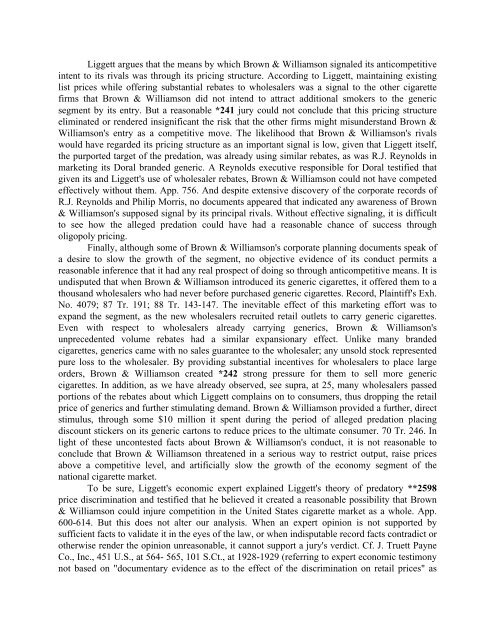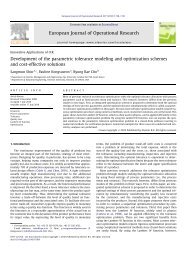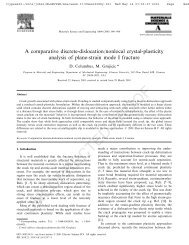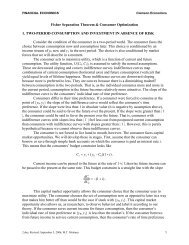509 U.S. 209, 113 S.Ct. 2578 BROOKE GROUP LTD., Petitioner v ...
509 U.S. 209, 113 S.Ct. 2578 BROOKE GROUP LTD., Petitioner v ...
509 U.S. 209, 113 S.Ct. 2578 BROOKE GROUP LTD., Petitioner v ...
Create successful ePaper yourself
Turn your PDF publications into a flip-book with our unique Google optimized e-Paper software.
Liggett argues that the means by which Brown & Williamson signaled its anticompetitive<br />
intent to its rivals was through its pricing structure. According to Liggett, maintaining existing<br />
list prices while offering substantial rebates to wholesalers was a signal to the other cigarette<br />
firms that Brown & Williamson did not intend to attract additional smokers to the generic<br />
segment by its entry. But a reasonable *241 jury could not conclude that this pricing structure<br />
eliminated or rendered insignificant the risk that the other firms might misunderstand Brown &<br />
Williamson's entry as a competitive move. The likelihood that Brown & Williamson's rivals<br />
would have regarded its pricing structure as an important signal is low, given that Liggett itself,<br />
the purported target of the predation, was already using similar rebates, as was R.J. Reynolds in<br />
marketing its Doral branded generic. A Reynolds executive responsible for Doral testified that<br />
given its and Liggett's use of wholesaler rebates, Brown & Williamson could not have competed<br />
effectively without them. App. 756. And despite extensive discovery of the corporate records of<br />
R.J. Reynolds and Philip Morris, no documents appeared that indicated any awareness of Brown<br />
& Williamson's supposed signal by its principal rivals. Without effective signaling, it is difficult<br />
to see how the alleged predation could have had a reasonable chance of success through<br />
oligopoly pricing.<br />
Finally, although some of Brown & Williamson's corporate planning documents speak of<br />
a desire to slow the growth of the segment, no objective evidence of its conduct permits a<br />
reasonable inference that it had any real prospect of doing so through anticompetitive means. It is<br />
undisputed that when Brown & Williamson introduced its generic cigarettes, it offered them to a<br />
thousand wholesalers who had never before purchased generic cigarettes. Record, Plaintiff's Exh.<br />
No. 4079; 87 Tr. 191; 88 Tr. 143-147. The inevitable effect of this marketing effort was to<br />
expand the segment, as the new wholesalers recruited retail outlets to carry generic cigarettes.<br />
Even with respect to wholesalers already carrying generics, Brown & Williamson's<br />
unprecedented volume rebates had a similar expansionary effect. Unlike many branded<br />
cigarettes, generics came with no sales guarantee to the wholesaler; any unsold stock represented<br />
pure loss to the wholesaler. By providing substantial incentives for wholesalers to place large<br />
orders, Brown & Williamson created *242 strong pressure for them to sell more generic<br />
cigarettes. In addition, as we have already observed, see supra, at 25, many wholesalers passed<br />
portions of the rebates about which Liggett complains on to consumers, thus dropping the retail<br />
price of generics and further stimulating demand. Brown & Williamson provided a further, direct<br />
stimulus, through some $10 million it spent during the period of alleged predation placing<br />
discount stickers on its generic cartons to reduce prices to the ultimate consumer. 70 Tr. 246. In<br />
light of these uncontested facts about Brown & Williamson's conduct, it is not reasonable to<br />
conclude that Brown & Williamson threatened in a serious way to restrict output, raise prices<br />
above a competitive level, and artificially slow the growth of the economy segment of the<br />
national cigarette market.<br />
To be sure, Liggett's economic expert explained Liggett's theory of predatory **2598<br />
price discrimination and testified that he believed it created a reasonable possibility that Brown<br />
& Williamson could injure competition in the United States cigarette market as a whole. App.<br />
600-614. But this does not alter our analysis. When an expert opinion is not supported by<br />
sufficient facts to validate it in the eyes of the law, or when indisputable record facts contradict or<br />
otherwise render the opinion unreasonable, it cannot support a jury's verdict. Cf. J. Truett Payne<br />
Co., Inc., 451 U.S., at 564- 565, 101 S.<strong>Ct</strong>., at 1928-1929 (referring to expert economic testimony<br />
not based on "documentary evidence as to the effect of the discrimination on retail prices" as
















